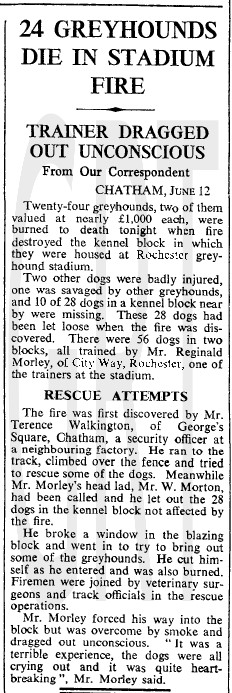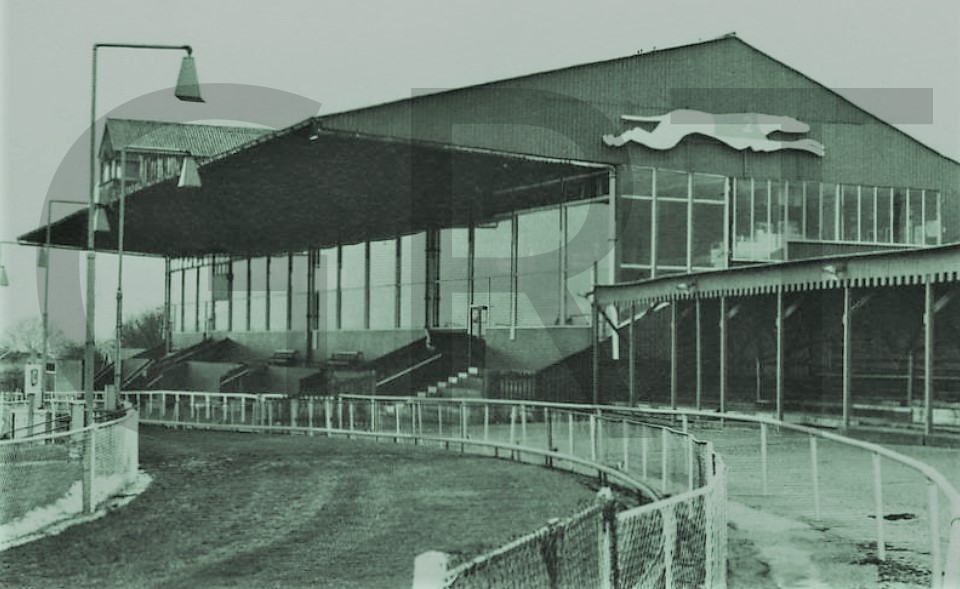Greater London Stadium, City Way, Rochester, Kent
POSTCODE———————————-ME1 2BT
LOCATED————————————Set back off the A229 City Way. two miles south of Rochester Railway Station.
ORIGINAL SITE—————————–Farm Grazing land used for Grass Track Speedway.
DATE CONSTRUCTED——————–1936
DATE VENUE OPENED——————-March 1932
Meaning other sports may have taken place prior to the arrival of Greyhound Racing.
FIRST MEETING—————————–March 16th 1932 as an independent venue, and June 1st 1936 as NGRC.
Greyhound Racing only.
LICENSED OR INDEPENDENT———-NGRC.
All venues covered would have to be licensed with the government, licensed suggested in this section would refer to tracks operating under NGRC Rules.
INSIDE OR OUTSIDE HARE TYPE——Outside Sumner.
Please note that the Electric Hare suggested is only a guidance, and would have been in operation for a certain amount of time at this venue. Although it is not necessarily guaranteed that it was operational all the time, as other types of lure may have been used and updated as time progressed.
DISTANCES———————————–277, 480 and 650 metres.
Please note that most racing venues distances had become varied throughout the years, the ones given above were at once point set and offers only a guidance to the track size.
CIRCUMFERENCE—————————Dont know.
Please note that alterations at most racing venues throughout its existence would see that the circumference of the track would vary, the one shown above offers only a guidance to the track size.
BIG RACE NAMES—————————None found.
STADIUM SHARED WITH——————Nothing known of.
LAST MEETING——————————-October 6th 1979.
Greyhound Racing only.
STADIUM CLOSURE DATE—————-October 1979.
Meaning other sports may have taken place after Greyhound Racing had ceased.
STADIUM DEMOLITION——————-1979-80.
BUILT ON SITE——————————-Cloisterham Road Estate with houses found along Barkis Close and Cloisterham Road, built during the early 1980’s.
In some cases, structure’s that originally covered the venue after the stadium had been demolished, may have been themselves demolished too, so the one described is more likely to be the one which now presently covers the site.
EVIDENCE LEFT TODAY——————-Nothing known of.
FURTHER COMMENTS——————–None

















The Kent town of Rochester lies roughly nineteen miles east of the M25 Dartford Crossing, a town which had developed around the Southern banks of the Thames Estuary. Rochester became just another town to host greyhound racing, with its purpose built stadium situated two miles south of its town centre. The venue became known as the The Greater London Greyhound Stadium, but its pioneering days was recognised as The Rochester and Chatham Stadium.
It was during the early months of 1932 that the venue began to take shape on grazing land close to the A229 City Way. It began operations on the 16th of March 1932, its intentional purpose was as a greyhound stadium, but soon become host grass track speedway, which would make its first appearance ten days later. Yet it would take another four years before further stadium improvements would class itself as a reasonably large venue, enough facilities to stage NGRC Racing.
Its first meeting under rules came on the 1st of June 1936, and became the 55th licensed NGRC track to open in the UK. Even though it operated throughout its days under the limelight of the NGRC, the venue’s history seemed to be riddled with controversy. A sad occasion happened in June of 1960, when the kennel block situated within the grounds of the stadium which housed 56 greyhounds caught fire, attempts were made to rescue the dogs by a nearby security guard, a trainer and a kennel hand who luckily enough managed to release some of the dogs from the blazing kennels. Sadly 24 greyhounds perished in the inferno, along with the fortunate trainer who had to be dragged out of the kennels unconscious due to smoke inhalation.
In 1965 the stadium attracted further bad publicity, after reports had been written in The Times Newspaper regarding that the track was under investigation due to a mass doping scandal of racing greyhounds there. Further bad publicity came in November 1975, after three men were cleared of a betting coup that had been worth over a million pounds, and also exposing some of the trainers who were acting as bookmakers as well as racing their dogs in the same races. Another dark cloud hovered during May 1978, after five men were suspected of fraud, after £300,000 had been won on two unknown greyhounds, the incident immediately caused suspicion amongst bookmakers who in turn refused to pay out on both winners. The case was taken through the courts but it took until 1985 before the case was eventually dropped, with the judge saying that the bookmakers would not liable to pay out on this case. Even with all the controversy that Rochester endured lets not forget that its races did consist of six greyhounds contesting over distances of 277, 480 and 650 metres, with the hounds chasing an outside Sumner type hare.
By 1979 rumours were spreading regarding the sale of the track, the whispers prompting that it had been sold to developers for a valuated half a million pounds. The stadium owners totally denied these reports, even guaranteeing owners and its five attached trainers, that it was business as usual for at least the next twelve months or so. Yet unknown to many associated with Rochester Stadium at the time, the final meeting had been run on the Saturday evening of the 6th of October 1979. But it was the following Monday that news filtered through that the stadium was about to close. As office staff began preparing the following Thursday evenings card, and also as the attached trainers were trialling their hounds, a phone call from the stadiums owners informed the stadiums management that the stadium was to close with immediate effect. The reaction to all concerned came as a shock, it was at this point that efforts were made to contact the stadiums owners for an explanation, but not surprisingly no contact seemed possible.
Within months of the stadiums closure, the site became demolished and the development of new housing began almost immediately. Today, the site is pinpointed by housing situated on Barkis Close and Cloisterham Road, leaving no trace whatsoever of a greyhound stadium ever being there.
A photograph or memorabilia for this track is required for this page, if you can help please contact me.

Recent Comments